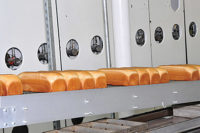Many bakers did quite well the first quarter of 1967, and the industry looked good financially. Several new product lines were being introduced, and there was plenty of buying and selling of businesses. Some large bakeries were witnessing the highest sales and earnings in their records.
Good Manufacturing Practices (GMPs) were new guidelines published by the FDA in 1969. They were designed to give procedures and methods to be used in food processing so as to maintain recommendations as to the proper sanitation. Most if not all of the procedures are followed by food manufactures that have sound sanitation programs.
BEMA threw support behind the passage of the Occupational Safety and Health Act (OSHA) in 1970, and also supported the Workmen’s Compensation Act. These acts passed Congress, were signed by the President and are still in force today. ConAgra was formed in 1974 through acquisitions such as Banquet Frozen Foods and Armour Foods. Mike Harper became the company’s first chief executive officer, and ConAgra grew to be one of the largest food companies in the country.
Regulatory affairs, Watergate
The 1970s also brought in an era of consumers who needed to know. It was also a time of changing and mounting regulations. Giving consumers nutritional information, Continental Baking Co. adopted an open-dating system on Wonder Bread and other products and introduced nutrition information labels that told consumers about freshness dates and product ingredients. This was evident with the baking associations. As the primary lobbying organization for the baking industry, ABA moved its headquarters to Washington, D.C. in the 1970s.
In 1974, the Food and Drug Administration (FDA) declined a proposal from the White House to double the permitted iron level in bread. This was initially proposed in order to eliminate iron deficiencies in Americans. Even though several physicians were against the increased level, nutritionists who supported food fortification finally convinced the FDA to pass the increased level. After the debate, the FDA concluded that future studies regarding added food fortification wouldn’t be necessary as long as there weren’t serious health concerns in doing so.
At the January, 1975 meeting of the AIB Board of Trustees, a recommendation came up to “initiate an immediate follow-up research project to examine the feasibility of moving AIB from Chicago to Manhattan, Kan., and establish a loose affiliation with Kansas State University.” Although the board accepted the recommendation in principle, it also voted to proceed with a study by board members and the AIB president to look at relocation options other than Kansas State University. AIB records note that, “a new era, fraught with both perils and possibilities, was about to open for the institute.”




















